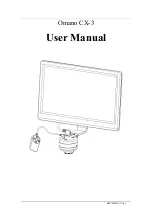
Manual No. OM5000
Jan X/04 Ver 1.40
6
t
'
2
x
v
Figure 1
where
t =
pulse-echo round trip across material sectional thickness
x =
material sectional thickness
v =
characteristic ultrasonic velocity for material
2 =
compensation factor for the fact that the round trip time
represents twice the time for the ultrasonic energy to travel
across the material thickness.
This relationship shows that, for a given material (of constant ultrasonic velocity), the pulse-echo
time period will double if the thickness doubles. Also, this linear relationship indicates that its pulse-
echo time period will be only half as long if the material's characteristic ultrasonic velocity is twice
that for another material of the same thickness. Thus, measurement of the pulse-echo time period
alone cannot sort out the individual effects of material thickness or ultrasonic velocity. The pulse-
echo period will determine (yield) a material's thickness only if the material's ultrasonic velocity is
known or compensated for (and vice-versa).
Fortunately, the characteristic velocity for a given applicable material is usually constant enough
(doesn't exhibit excessive unknown, inherent velocity variations) to permit accurate thickness
measurement. In fact, many common industrial materials have velocities so constant that very
precise measurements can be made. However, changes in composition, grain structure/direction
and even temperature or residual/applied stress can affect the characteristic velocity for a given
material - resulting in thickness gaging errors (the magnitude depending upon the degree of change
in the material).
All factors considered, the ultrasonic pulse-echo ranging concept is a practical and well-proven
method to measure material thickness.
4.2 INSTRUMENTATION CONCEPTS
4.2.1 Basic Pulse-Echo Circuit
- Figure
1 shows a highly simplified functional
diagram for the NovaScope. The basic
components of this functional circuit
include a pulser, transducer, receiver, and
display (digital readout plus scope).
The pulser is an electronic circuit that
generates a very short-duration electrical
pulse, having an adjustable amplitude
typically in the range of 90 to 350 volts
(peak). Since the risetime of the pulse is
about 10 nanoseconds (billionths of a
second), it has electrical characteristics (spectral) well into the desired megahertz region.
The transducer is generally an ultrasonic transceiving probe that contains a piezoelectric material













































